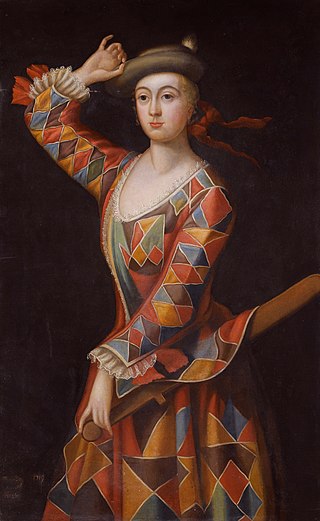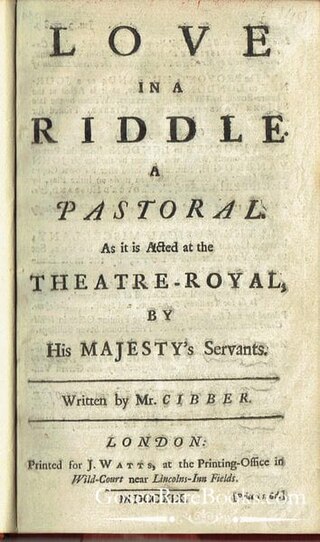
Colley Cibber was an English actor-manager, playwright and Poet Laureate. His colourful memoir An Apology for the Life of Colley Cibber (1740) describes his life in a personal, anecdotal and even rambling style. He wrote 25 plays for his own company at Drury Lane, half of which were adapted from various sources, which led Robert Lowe and Alexander Pope, among others, to criticise his "miserable mutilation" of "crucified Molière [and] hapless Shakespeare".

The Relapse, or, Virtue in Danger is a Restoration comedy from 1696 written by John Vanbrugh. The play is a sequel to Colley Cibber's Love's Last Shift, or, The Fool in Fashion.
This article contains information about the literary events and publications of 1717.

Anne Oldfield was an English actress and one of the highest paid actresses of her time.
Barton Booth was one of the most famous dramatic actors of the first part of the 18th century.

Pantomime is a type of musical comedy stage production designed for family entertainment. It was developed in England and is performed throughout the United Kingdom, Ireland and in other English-speaking countries, especially during the Christmas and New Year season. Modern pantomime includes songs, gags, slapstick comedy and dancing. It generally combines gender-crossing actors and topical humour with a story more or less based on a well-known fairy tale, fable or folk tale. Pantomime is a participatory form of theatre, in which the audience is encouraged and expected to sing along with certain parts of the music and shout out phrases to the performers.
Mary Kent was an English actress, whose career lasted from 1692 to 1718. Her dates of birth and death are not known. She was the wife of Drury Lane actor Thomas Kent.

John Weaver is widely regarded as the father of English ballet and of English pantomime.

Robert Wilks was a British actor and theatrical manager who was one of the leading managers of Theatre Royal, Drury Lane in its heyday of the 1710s. He was, with Colley Cibber and Thomas Doggett, one of the "triumvirate" of actor-managers that was denounced by Alexander Pope and caricatured by William Hogarth as leaders of the decline in theatrical standards and degradation of the stage's literary tradition.

Hester Santlow was a noted British dancer and actress, who has been called "England's first ballerina". She was influential in many spheres of theatrical life.
Events from the year 1717 in Great Britain.
James Oates was a British stage actor.
John Mills (c.1670–1736) was a British stage actor. A long-standing part of the Drury Lane company from 1695 until his death, he appeared in both comedies and tragedies. His wife Margaret Mills was an actress, and his son William Mills also became an actor at Drury Lane.

The Refusal, Or, The Ladies Philosophy is a 1721 comedy play by the British writer Colley Cibber. It is a reworking of the 1672 farce Les Femmes Savantes by Molière, with reference to the recent South Sea Bubble.
Caesar in Egypt is a 1724 tragedy by the British writer Colley Cibber. It is inspired by Pierre Corneille's 1642 French play The Death of Pompey about Julius Caesar's intervention in the Egyptian Civil War between Cleopatra and her brother. Cibber also incorporated elements of Plutarch and John Fletcher's The False One. The Drury Lane company invested lots of resources to make it a particularly extravagant production in the traditional style of a Restoration heroic drama.
Jane Cibber was a British stage actress.

Love in a Riddle is a 1729 ballad opera by the British actor-manager Colley Cibber. It was part of a boom in ballad operas inspired by the enormous success of John Gay's The Beggar's Opera the previous year.
Love in a Forest is a 1723 comedy play by Charles Johnson. It is a substantial reworking of Shakespeare's As You Like It cutting out characters and passages, while borrowing from other Shakespeare plays amongst other things.
The Non-Juror is a 1717 comedy play by the British writer Colley Cibber. It is inspired by Molière's 1664 work Tartuffe.
John Thurmond was a British stage actor. To distinguish him from his son, also an actor named John, he is sometimes called John Thurmond the Elder.








